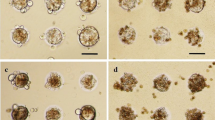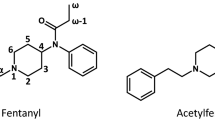Abstract
Cells in culture were investigated for the expression of monooxygenase and UDP-glucuronyltransferase activities as representatives of activating and inactivating pathways of drug metabolism. Most established cell lines express monooxygenase activity that is detected by the oxygenation of polycyclic hydrocarbons and appears to be a function of cytochrome P-448-dependent enzyme forms (Wiebel et al., 1977). In the hepatoma cell line, H-4-II-E, dexamethasone is capable of increasing the level of benzo(a)pyrene-monooxygenation about 10-fold and of potentiating its induction by benz(a)anthracene. The enzyme activities elicited by dexamethasone and the polycyclic hydrocarbon did not significantly differ in their response to 7,8-benzoflavone, an inhibitor of cytochrome P-448-dependent monooxygenases. Observations on the pattern of benzo(a)pyrene metabolites formed in benz(a)anthracene-treated H-4-II-E and BHK21(C13) cells indicate that established cell cultures may contain different forms of monooxygenases of the cytochrome P-448 type.
The majority of cell lines tested express UDP-glucuronyltransferase activity directed toward the substrate, 3-hydroxybenzo(a)pyrene. No clear correlation appears to exist between the presence and level of monooxygenase and glucuronyltransferase activities in the various cell lines, i.e., the cultures may express any one or both enzymes. The ratio of the two enzyme levels can be modified by selective induction. Thus, at present there is a choice of established cells in culture exhibiting widely differing ratios of activating and inactivating enzymes to analyse the metabolic pathways of selected classes of foreign compounds, such as polycyclic hydrocarbons, and to determine their toxicological significance. Further efforts are likely to yield cell lines that express the enzymic functions lacking in the cultures currently used and will be suitable to study the full spectrum of foreign compounds.
Similar content being viewed by others
References
Andrae, U., Greim, H.:Induction of DNA repair replication by hydroxyurea in human lymphoblastoid cells mediated by liver microsomes and NADPH. Biochem. Biophys. Res. Commun. 87, 50–58 (1979)
Atlas, S. A., Boobis, A. R., Felton, J. S., Thorgeirsson, S. S., Nebert, D. W.: Ontogenetic expression of polycyclic aromatic compound-inducible monooxygenase activities and forms of cytochrome P-450 in rabbit. J. Biol. Chem. 252, 4712–4721 (1977)
Baur, H., Pfaff, E.: Criteria of viability of isolated liver cells. Hoppe-Seylers Z. Physiol. Chem. 355 (Abstr.), 5 (1974)
Bock, K. W., Lilienblum, W.: Activation and induction of rat liver microsomal UDP-glucuronyltransferase with 3-hydroxybenzo(a)pyrene and N-hydroxy-2-naphthylamine as substrates. Biochem. Pharmacol. 28, 695–700 (1979)
Bock, K. W., von Clausbruch, U. C., Josting, D., Ottenwälder, H.: Separation and partial purification of two differentially inducible UDP-glucuronyltransferases from rat liver. Biochem. Pharmacol. 26, 1097–1100 (1977)
Brown, S., Wiebel, F. J., Gelboin, H. V., Minna, J. D.: Assignment of a locus required for flavoproteinlinked monooxygenase expression to human chromosome 2. Proc. Natl. Acad. Sci. USA 73, 4628–4632 (1976)
Creaven, P. J., Parke, D. V.:The stimulation of hydroxylation by carcinogenic and non-carcinogenic compounds. Biochem. Pharmacol. 15, 7–16 (1966)
Diamond, L.: Metabolism of polycyclic hydrocarbons in mammalian cell cultures. Int. J. Cancer 8, 451–462 (1971)
Fahl, W. E., Michalopoulos, G., Sattler, G. L., Jefcoate, C. R., Pitot, H. C.:Characteristics of microsomal enzyme controls in primary cultures of rat hepatocytes. Arch. Biochem. Biophys. 192, 61–72 (1979)
Fox, C. H., Selkirk, J. K., Price, F. M., Croy, R. G., Sanford, K. K., Cottler-Fox, M.: Metabolism of benzo(a)pyrene by human epithelial cells in vitro. Cancer Res. 35, 3551–3557 (1975)
Frommer, U., Ullrich, V., Orrenius, S.:Influence of inducers and inhibitors on the hydroxylation pattern of N-hexane in rat liver microsomes. FEBS Lett. 41, 14–16 (1974)
Gelboin, H. V., Wiebel, F. J.:Studies on the mechanism of aryl hydrocarbon hydroxylase induction and its role in cytotoxicity and tumorigenicity. Ann. N.Y. Acad. Sci. 179, 529–547 (1971)
Goto, T., Wiebel, F. J.: Aryl hydrocarbon (benzo(a)pyrene) monooxygenase activity in human primary amnion cell cultures. Eur. J. Cancer Res. (In press, 1980)
Guenthner, T. M., Nebert, D. W.:Evidence in rat and mouse liver for temporal control of two forms of cytochrome P-450 inducible by 2,3,7,8-tetrachlorodibenzo-p-dioxin. Eur. J. Biochem. 91, 449–456 (1978)
Guzelian, P. S., Bissell, D. M., Meyer, U. A.: Drug metabolism in adult rat hepatocytes in primary monolayer culture. Gastroenterology 72, 1232–1239 (1977)
Haugen, D. A., van der Hoeven, T. A., Coon, M. C.: Purified liver microsomal cytochrome P-450. Separation and characterization of multiple forms. J. Biol. Chem. 250, 3567–3570 (1975)
Heidelberger, C.: Chemical oncogenesis in culture. Adv. Cancer Res. 18, 317–366 (1975)
Holder, G., Yagi, H., Dansette, P., Jerina, D. M., Levin, W., Lu, A. Y. H., Conney, A. H.:Effects of inducers and epoxide hydrase on the metabolism of benzo(a)pyrene by liver microsomes and a reconstituted system: analysis by high pressure liquid chromatography. Proc. Natl. Acad. Sci. USA 71, 4356–4360 (1974)
Huberman, E., Sachs, L.: Cell-mediated mutagenesis of mammalian cells with chemical carcinogens. Int. J. Cancer 13, 326–333 (1974)
Jensen, E. M., Zelljadt, I., Chopra, H. C., Mason, M. M.:Isolation and propagation of a virus from a spontaneous mammary carcinoma of a Rhesus monkey. Cancer Res. 30, 2388 (1970)
Johnson,E. F.,Zounes,M. C.,Muller-Eberhard, U.:Characterization of three forms of rabbit microsomal cytochrome P-450 by peptide mapping utilizing limited proteolysis in sodium dodecyl sulfate and analysis by gel electrophoresis. Arch. Biochem. Biophys. 192, 282–289 (1979).
King, H. W. S., Osborne, M. R., Beland, F. A., Harvey, R. G., Brookes, P.: (±)-7,8β-Dihydroxy9β, 10β-epoxy-7,8,9,10-tetrahydrobenzo(a)pyrene is an intermediate in the metabolism and binding to DNA of benzo(a)pyrene. Proc. Natl. Acad. Sci. USA 73, 2679–2681 (1976)
Kouri, R. E., Kiefer, R., Zimmerman, E. M.: Hydrocarbon-metabolizing activity of various mammalian cells in culture. In Vitro 10, 18–25 (1974)
Krahn, D. F., Heidelberger, C.:Liver homogenate-mediated mutagenesis in Chinese hamster V79 cells by polycyclic hydrocarbons and aflatoxins. Mutat. Res. 46, 27–44 (1977)
Kuroki, T., Drevon, C., Montesano, R.: Microsome-mediated mutagenesis in V79 Chinese hamster cells by various nitrosamines. Cancer Res. 37, 1044–1050 (1977)
Lambiotte, M., Sjövall, J.:Hydroxylation and sulfation of bile acids in rat hepatoma cultures under the influence of a glucocorticoid. Biochem. Biophys. Res. Commun. 86, 1089–1095 (1979)
Lambiotte, M., Thierry, N.:Enhancement of aflatoxin B1 in differentiated rat hepatoma cultures by a prior glucocorticoid treatment of the monolayer. Biochem. Biophys. Res. Commun. 89, 933–942 (1979)
Lotlikar, P. D., Hong, S. Y., Baldy, W. J., Jr.: Effect of 3-methylcholanthrene pretreatment on 2-acetylaminofluorene N- and ring-hydroxylation by rat and hamster liver microsomes. Toxicol. Lett. 2, 135–139 (1978)
Lowry, O. H., Rosebrough, N. J., Farr, A. L., Randall, R. J.: Protein measurement with the Folin phenol reagent. J. Biol. Chem. 193, 265–275 (1951)
Lu, A. Y. H.: Liver microsomal drug-metabolizing enzyme system: Functional components and their properties. Fed. Proc. 35, 2460–2463 (1976)
Marquardt, H., Heidelberger, C.: Influence of “feeder” cells and induction and inhibition of microsomal mixed-function oxidases on hydrocarbon-induced malignant transformation of cells derived from C3H mouse prostate. Cancer Res. 32, 721–725 (1972)
Miller, J.: Carcinogenesis by chemicals: An overview. G. H. A.: Clowes memorial lecture. Cancer Res. 30, 559–576 (1970)
Nebert, D. W., Gelboin, H. V.: Substrate-inducible microsomal aryl hydrocarbon hydroxylase in mammalian cell culture. I. Assay and properties of induced enzyme. J. Biol. Chem. 243, 6242–6249 (1968)
Niwa, A., Kumaki, K., Nebert, D. W.: Induction of aryl hydrocarbon hydroxylase activity in various cell cultures by 2,3,7,8-tetrachlorodibenzo-p-dioxin. Mol. Pharmacol. 11, 399–408 (1975)
Oesch, F.: Mammalian epoxide hydrases: Inducible enzymes catalyzing the inactivation of carcinogenic and cytotoxic metabolites derived from aromatic and olefinic compounds. Xenobiotica 3, 305–340 (1973)
Owens, I. S., Nebert, D.W.: Aryl hydrocarbon hydroxylase induction in mammalian liver-derived cell cultures. Stimulation of “cytochrome P1-450-associated” enzyme activity by many inducing drugs. Mol. Pharmacol. 11, 94–104 (1975)
Schwarz, L. R., Götz, R., Wolff, Th., Wiebel, F. J.: Monooxygenase and glucuronyltransferase activities in short term cultures of isolated rat hepatocytes. FEBS Lett. 98, 203–206 (1979)
Selkirk, J. K., Croy, R. G., Wiebel, F. J., Gelboin, H. V.: Differences in benzo(a)pyrene metabolism between rodent liver microsomes and embryonic cells. Cancer Res. 36, 4476–4479 (1976)
Shinohara, K., Cerutti, P. A.: Formation of benzo(a)pyrene-DNA adducts in peripheral human lung tissue. Cancer Lett. 3, 303–309 (1977)
Sims, P.: The metabolism of some aromatic hydrocarbons by mouse embryo cell cultures. Biochem. Pharmacol. 19, 285–297 (1970)
Singh, J., Wiebel, F. J.: A highly sensitive and rapid fluorometric assay for UDP-glucuronyltransferase activity using 3-hydroxybenzo(a)pyrene as substrate. Anal. Biochem. 98, 394–401 (1979)
Thorgeirsson, S. S., Atlas, S. A., Boobis, A. R., Felton, J. S.: Species differences in the substrate specificity of hepatic cytochrome P-448 from polycyclic hydrocarbon-treated animals. Biochem. Pharmacol. 28, 217–226 (1979)
Umeda, M., Saito, M.: Mutagenicity of dimethylnitrosamine to mammalian cells as determined by the use of mouse liver microsomes. Mutat. Res. 30, 249–254 (1975)
Whitlock, J. P., Jr., Miller, H., Gelboin, H. V.: Induction of aryl hydrocarbon (benzo(a)pyrene) hydroxylase and tyrosine aminotransferase in hepatoma cells in culture. J. Cell Biol. 63, 136–145 (1974)
Wiebel, F. J.: Activation and inactivation of carcinogenesis by microsomal monooxygenase: Modification by benzoflavones and polycyclic aromatic hydrocarbons. In: Carcinogenesis, vol. 5. Modifiers of chemical carcinogenesis. Slaga, T. J. (ed.), pp. 57–84. New York: Raven Press 1979
Wiebel, F. J., Gelboin, H. V., Coon, H. G.: Regulation of aryl hydrocarbon hydroxylase in intraspecific hybrids of human, mouse, and hamster cells. Proc. Natl. Acad. Sci. USA 69, 3580–3584 (1972a)
Wiebel, F. J., Matthews, E. J., Gelboin, H. V.: Ribonucleic acid synthesis-dependent induction of aryl hydrocarbon hydroxylase in the absence of ribosomal ribonucleic acid synthesis and transfer. J. Biol. Chem. 247, 4711–4747 (1972b)
Wiebel, F. J., Leutz, J. C., Diamond, L., Gelboin, H. V.: Aryl hydrocarbon (benzo(a)pyrene) hydroxylase in microsomes from rat tissues: differential inhibition and stimulation by benzoflavones and organic solvents. Arch. Biochem. Biophys. 144, 78–86 (1971)
Wiebel, F. J., Selkirk, J. K., Gelboin, H. V., Haugen, D. A., Van der Hoeven, T. A., Coon, M. J.: Position-specific oxygenation of benzo(a)pyrene by different forms of purified cytochrome P-450 from rabbit liver. Proc. Natl. Acad. Sci. USA 72, 3917–3920 (1975)
Wiebel, F. J., Brown, S., Waters, H. L., Selkirk, J. K.: Activation of xenobiotics by monooxygenases: Cultures of mammalian cells as analytical tool. Arch. Toxicol. 39, 133–148 (1977)
Wiebel, F. J., Schwarz, L. R., and Goto, T.: Mutagen-metabolizing enzymes in mammalian cell cultures: Possibilities and limitations for mutagenicity screening. In: Short-term mutagenicity test systems for detecting carcinogens. Norpoth, K., Garner, R. C. (eds.). Berlin, Heidelberg, New York: Springer (In press, 1980)
Wiebel, F. J., Wolff, T., Lambiotte, M.: Presence and inducibility of different monooxygenase forms in various cell lines. Ann. N.Y. Acad. Sci. (in press, 1980)
Wishart, G. J.: Demonstration of functional heterogeneity of hepatic uridine diphosphate glucuron-osyltransferase activities after administration of 3-methylcholanthrene and phenobarbital to rats. Biochem. J. 174, 671–672 (1978)
Yamasaki, H., Huberman, E., Sachs, L.: Regulation of aryl hydrocarbon (benzo(a)pyrene) hydroxylase activity in mammalian cells. Induction of hydroxylase activity by dibuturylcyclic AMP and aminophylline. J. Biol. Chem. 250, 7766–7770 (1975)
Yang, S. K., Gelboin, H. V., Trump, B. F., Autrup, H., Harris, C. C.: Metabolic activation of ben-zo(a)pyrene and binding to DNA in cultured human bronchus. Cancer Res. 37, 1210–1215 (1977)
Zampaglione, N., Jollow, D. J., Mitchell, J. R., Stripp, B., Hamrick, M., Gillette, J. R.: Role of detoxifying enzymes in bromobenzene-induced liver necrosis. J. Pharmacol. Exp. Ther. 187, 218–227 (1973)
Author information
Authors and Affiliations
Rights and permissions
About this article
Cite this article
Wiebel, F.J., Singh, J. Monooxygenase and UDP-glucuronyltransferase activities in established cell cultures. Arch. Toxicol. 44, 85–98 (1980). https://doi.org/10.1007/BF00303185
Received:
Issue Date:
DOI: https://doi.org/10.1007/BF00303185




